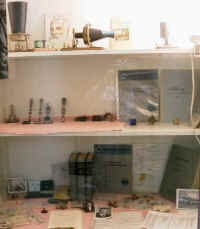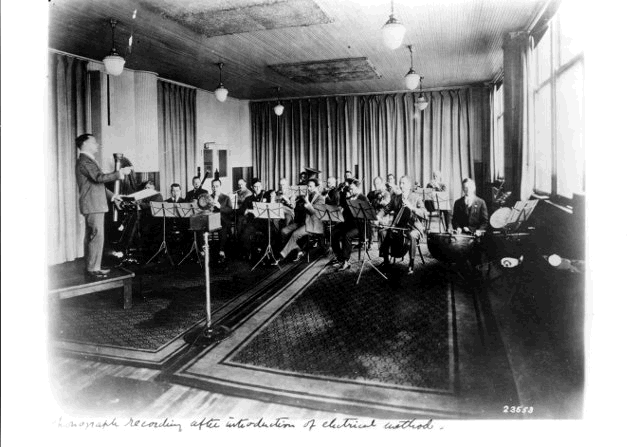| FOLLOW THE LINKS AT TOP OF PAGE |
|
Just a few of the many Bell related this we have in the archives... Ranging from Historical models of bell's first apparatus to prototype and production models of Electron devices. |
|
Bell Labs Receives Technical Grammy(R) Award
for Its Pioneering R&D Contributions to Sound Recording and
Digital Communications
MURRAY HILL, N.J., Jan. 10 /PRNewswire-FirstCall/ -- Bell Labs, the research and development arm of Lucent Technologies (NYSE: LU), today announced it has been awarded a Technical GRAMMY(R) Award by The Recording Academy(R) for its outstanding technical contributions to the recording field. This is the first Technical GRAMMY ever awarded to a communications research laboratory.
The award is a Special Merit Award presented to individuals and/or
companies who have made contributions of outstanding technical significance to
the recording field. Technical GRAMMY Award recipients are determined by vote
of the members of The Recording Academy Producers & Engineers Wing and The
Academy's Trustees. The Technical GRAMMY Award will be presented on Feb. 7, at
the Wilshire Ebell Theatre. The 48th Annual GRAMMY Awards will be held on
Wednesday, Feb. 8, at STAPLES Center in Los Angeles, and will be broadcast
live in high-definition TV and 5.1 surround sound on CBS from 8 - 11:30 p.m.
(ET/PT).
From the invention of the telephone, the first device to electronically
transmit and receive sound, to its more recent R&D projects for digital sound
capture and delivery technologies, Bell Labs has been a consistent pioneer in
both the foundational and applied technologies of modern sound recording,
electronic transmission, and digital communications. Seminal Bell Labs sound
and audio inventions include high fidelity recording (1925), single groove
stereo recording (1933), stereophonic recording on film (1941), the laser
(1958), today used in all CD and DVD players, the electret microphone (1966),
and advances in audio compression to facilitate digital radio technology
(1992 - 1999), which allows AM, FM, and satellite stations to broadcast
near-CD quality music. For a complete timeline please visit
http://www.bell-labs.com/sound
Bell Labs continues to innovate in this space. Current research and
development at Bell Labs has expanded to include audio as part of a blended
multimedia experience, work on new digital compression technologies for
delivering music and other medias over a wide variety of networks and devices,
nano-based "micro-microphones" for dynamically directional, high quality sound
recording, and flexible and tunable hypersensitive recording arrays for
improved sound capture. Some of Bell Labs' longer term research projects in
this area include the investigation of new types of lasers, materials, and
processing formats that have the potential to yield the next generation of
high density media storage and advanced digital playback technologies.
"Bell Labs continues to be laser-focused on communication innovations, the
fruits of which continue to enrich our everyday lives by providing continual
improvements for how we create, capture, and enjoy digital entertainment such
as music," said Sid Ahuja, Vice President of Software Media Research whose
center oversees current multimedia, digital entertainment, acoustics, and
speech research efforts. "We are honored to be receiving this Technical
GRAMMY and we look forward to making many more contributions to the field in
the years ahead."
About Bell Labs and Lucent Technologies
Bell Labs is the leading source of new communications technologies and has
been for eighty years. It has generated more than 31,000 patents since 1925
and has played a pivotal role in inventing or perfecting key communications
technologies, including transistors, digital networking and signal processing,
lasers and fiber-optic communications systems, communications satellites,
cellular telephony, electronic switching of calls, touch-tone dialing, and
modems. Bell Labs scientists have received six Nobel Prizes in Physics, nine
U.S. National Medals of Science and eight U.S. National Medals of Technology.
Lucent Technologies designs and delivers the systems, services and
software that drive next-generation communications networks. Backed by Bell
Labs research and development, Lucent uses its strengths in mobility, optical,
software, data and voice networking technologies, as well as services, to
create new revenue-generating opportunities for its customers, while enabling
them to quickly deploy and better manage their networks. Lucent's customer
base includes communications service providers, governments and enterprises
worldwide. For more information on Lucent Technologies, which has
headquarters in Murray Hill, N.J., USA, visit http://www.lucent.com.
SOURCE Lucent Technologies Bell Labs
|


